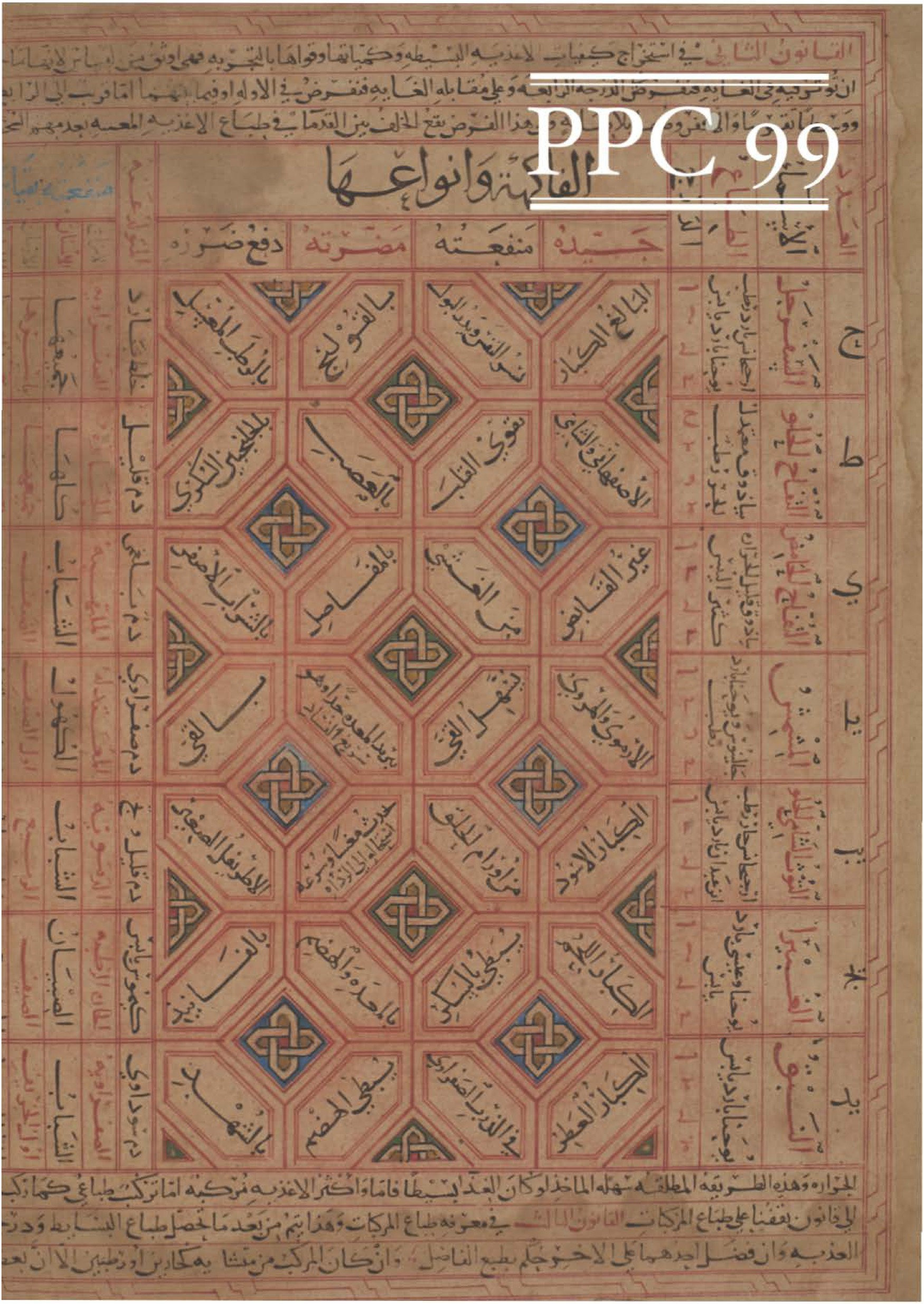The Tacuinum Sanitatis
A Medieval Health Manual
DOI:
https://doi.org/10.1558/ppc.28448Keywords:
Tacuinum Sanitatis, medieval, health manuals, humoral theory, medieval europe, diet, islamic medicine, materia medica, intercultural ecounter, Taqwīm al-Sihha, translation, reception history, audience analysisAbstract
The article concerns an Arab physician whose works were among those translated into Latin in the early medieval period -- Ibn Butlan, an eleventh-century Christian physician from Baghdad, who compiled the Taqwim al-Sihha (Tables of Health). This is a a tabular compilation of 280 items which was translated and published in several editions, mostly of Italian origin. These versions – nearly all known as the Tacuinum Sanitatis – became quite popular in the fourteenth and fifteenth centuries. The reason for its popularity is a matter still subject to debate. The original Arabic version includes no images; however, this was not the case in the Latin versions of the late Middle Ages. Each entry included a detailed illustration. The article compares the Arabic and Latin manuscripts for the purposes of examining two key differences and to discuss what they show us about the two cultures that generated and used them.
References
Bovey, A., 2005. Tacuinum Sanitatis: An Early Renaissance Guide to Health. London: Sam Fogg. A museum catalogue accompanying an exhibition held at Sam Fogg in London, July 2005, contains more colour facsimiles of the Rouen 3054/Lichtenstein manuscripts than any other collection.
British Library, Or. 1347, folios 4b–5a. Used with permission.
Cogliati Arano, L., 1976. The Medieval Health Handbook: Tacuinum Sanitatis. New York: George Braziller. Translated from the Italian edition (Tacuinum Sanitatis. Milan: Electa Editrice.) Includes facsimile images selected from the illustrations in the Paris 1673, Liege 1041, Vienna 2644, Rome 4182, and Rouen 3054 manuscripts, many of which are in colour.
Elkhadem, H., 1990. Le Taqwim al-Sihha (Tacuini Sanitatis) d’Ibn Butlan: un traité medical du XI e siècle. Lovanii: Peeters. The complete Taqwim al-Sihha in Arabic together with a French translation with commentary and notes. This is a critical edition: Elkhadem examined fifteen known Arabic manuscripts of the Taqwim to produce a single text.
Fourth Lateran Council, 1215. Canon 22. [online] Available at http://www.fordham.edu/halsall/basis/lateran4.asp. [Accessed 2 February 2013.]
Freedman, P., 2008. Out of the East: Spices and the Medieval Imagination. New Haven: Yale University Press. A history of spices and their use.
Laurioux, B., 2005. Une Histoire culinaire du Moyen Âge. Paris: Champion.
Leiden University Library. Ms. Or. 289, f. 39a. Used by permission
Nasrallah, N., 2007. Annals of the Caliphs’ Kitchens: Ibn Sayyar al-Warraq’s Tenth century Baghdadi Cookbook. Leiden: Brill. This volume was most useful for its multiple glossaries of Arabic culinary terms.
Opsomer-Halleux, C., 1991. L’Art de vivre en sante: Images et recettes du moyen âge: Le Tacuinum Sanitatis (manuscrit 1041) de la Bibliothèque de l’Université de Liège. Liege: Perron. A collection of many images from the Liege 1041 manuscript.
Paris, H.S.; Daunay, H.-C.; Janick, J., 2009. ‘The Cucurbitaceae and Solanaceae illustrated in medieval manuscripts known as the Tacuinum Sanitatis’, Annals of Botany, 103(8), pp. 1187–1205. Focused on historic botany, this article is an example of the use of the illustrated Tacuinum manuscripts to derive information other than the intended use. In this case, the authors have used the images to identify species of melons, squash, and related food plants that were common in the 14th and 15th centuries.
Peterson, T., 1980, ‘The Arab influence on Western European cooking’, Journal of Medieval History, 6(3), pp. 317–340.
Rodinson, M., 2006. ‘Ma’muniyya East and West’, and , ‘Romania and other Arabic words in Italian’, in: M. Rodinson, A.J. Arberry, and C. Perry, 2006. Medieval Arab Cookery. Prospect Books, pp. 183–197 and 163–182 respectively. Both articles discuss the adaptation and use of Islamic recipes in medieval Europe.
Rössl, J.; Konrad, H., 1984. Vollständige Faksimileausgabe im Originalformat des Codex 2396 der Österreichischen Nationalbibliothek. Kommentar. Graz: Akademische Druck-u, Verlagsanstalt. This is the commentary volume associated with the Vienna 2396 facsimile. It includes a complete transcription of the Latin Tacuinum, with a parallel German translation.
Touwaide, A., 2012. (Personal communication, 17 October 2012).
Vernet, J. 2008. Ibn Al-Baytar Al-Malaqi, Diya’ Al-Din Abu Muhammad ‘Abdllah Ibn Ahmad. In: Gale Virtual Reference Library, 2008. Complete Dictionary of Scientific Biography. [e-book]. Available through: City College of New York Library website <http://libguides.ccny.cuny.edu/> [Accessed 1 Feb. 2013].
Yale University, Cushing/Whitney Medical Library, Codex Fritz Paneth, folios 690v–691r. Used with permission.
Facsimile Editions Consulted
The descriptions of the facsimile editions are taken from the online catalogue of the Morgan Library and Museum (http://corsair.themorgan.org/), where most of my research was performed.
Tacuinum sanitatis: Österreichische Nationalbibliothek, Vienna 2396. (1984). Enchiridion virtutum vegetabilium, animalium, mineralium rerumque omnium: explicans naturam, iuvamentum, nocumentum remotionemque nocumentoru[m] eorum. Graz: Akademische Druck- u. Verlagsanstalt. Full-colour facsimile. This version contains more descriptions (294) than the other Tacuinum manuscripts and adheres more to Ibn Butlan’s system for their arrangement.
Tacuinum sanitatis: Österreichische Nationalbibliothek, Vienna 2644. (2004). Tacuinum sanitatis in medicina: Codex Vindobonensis series nova 2644 der Österreichische Nationalbibliothek. Kommentar von Franz Unterkircher. Tacuinum sanitatis (Österreichische Nationalbibliothek, Vienna 2644) Graz: Akademische Druck- u. Verlagsanstalt, 2004. Commentary in German, with transcriptions from MS in Latin and German. Contains full-colour fascimile of the complete Tacuinum sanitatis originally owned by the Cerutti family of Verona. MS produced in northern Italy, possibly in Verona, at the end of the 14th century. One of several illustrated Tacuina, the captions or text of which are based on Ibn Butlan’s Taqwim al-Sihha.
Tacuinum sanitatis. Bibliotheque Nationale de France, Paris 9333. (2007). Barcelona: M. Moleiro. Includes transcription of the Latin, with subsequent German translations. Full-colour facsimile of Bibliotheque Nationale de France, Paris 9333, produced in the Rhineland in the mid-15th century. Includes commentary by A. Touwaide, E. König and C.M. García-Tejedor.
Theatrum sanitatis. Biblioteca casanatense, Rome 4182. (1999). Barcelona: Moleiro. Includes essays in Spanish with English translations; captions to manuscript illustrations translated from Latin into Spanish and English.

